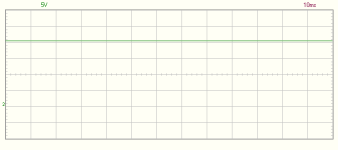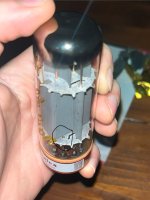That would be correct. Connecting the + side of the cap to the surpressor and the - side to the cathode.
And to make things even more interesting: I use this mod while runnig the KT77 which hase the surpressor tied to the cathode internally already and notice the differences clearly and they can be measured. I can A/B test this constantly by using a switch.
Like how would this even be possible. I am now starting to doubt what is really going on. It also would not make sense to me this somehow impacts the cathode bypass capacitor. I have the Hazen capacitor mounted from Pin 1 to Pin 8 with the KT77 in place. The cathode bias and bypass are connected to pin 8. So that is correct. There should be no current going between the surpressor and cathode with the KT77 in place, yet a profound effect on the sound is heard.
I will measure the Hazen capacitor when I get home fro work to see what is happening there.
Like how would this even be possible. I am now starting to doubt what is really going on. It also would not make sense to me this somehow impacts the cathode bypass capacitor. I have the Hazen capacitor mounted from Pin 1 to Pin 8 with the KT77 in place. The cathode bias and bypass are connected to pin 8. So that is correct. There should be no current going between the surpressor and cathode with the KT77 in place, yet a profound effect on the sound is heard.
I will measure the Hazen capacitor when I get home fro work to see what is happening there.
Last edited:
So you are claiming a capacitor soldered with its positive and negative pole to a piece of wire improves the sound of your amp?
Yes Bas. It seems so. I will get back to it when I get home from work to see what really is going on. Something is happening, but it would not make sense as pin 1 on the KT77 is not wired internally. The capacitor therefore would have no current going throuhg it, yet a clear difference is heard. Not a "difference" people calim to hear wth powercables or RCA cables / USB cables. IT is like proper holography and no harshness vs a flatter image and harshness.
I will try to take measurements where possible so we can get a look at what is happening.
I will try to take measurements where possible so we can get a look at what is happening.
O I assumed pin 1 was the suppressor grid internally connected to 8. Anyway...still does not make sense.
Random thought: Maybe it is stray capacitance / parasitic capacitance having an effect on the cathode bypass capacitor as they are near each otcher resulting in "better" sound in this case.
Last edited:
As promised here are the first measurements. I am quite stunned.
Though the capacitor is not connected in the loop, it reacts to whatever I put through the amp. Here I tested with a sine wave.
This wasn’t even at listening volume.
With an EL34 in place I get about the same response. Say that the wave is about 20% larger.
Riddle me this…
EDIT: Added a picture of the KT77. There is a connection from pin 1 to the baseplate. But no further connection than that. On an EL34 there would be an additional wire going from that base to the surpressor or grid.
Though the capacitor is not connected in the loop, it reacts to whatever I put through the amp. Here I tested with a sine wave.
This wasn’t even at listening volume.
With an EL34 in place I get about the same response. Say that the wave is about 20% larger.
Riddle me this…
EDIT: Added a picture of the KT77. There is a connection from pin 1 to the baseplate. But no further connection than that. On an EL34 there would be an additional wire going from that base to the surpressor or grid.
Attachments
Last edited:
This will be my last post regarding this “issue”.
I had some new bypass capacitors I wanted to install which lead to a slightly different internal layout. If I add the Hazen capacitor it has no effect now except the EL34 obviously. Also nothing shows on the scope with the KT77 in place.
Could it be stray capacitance causing what has been experienced here?
I had some new bypass capacitors I wanted to install which lead to a slightly different internal layout. If I add the Hazen capacitor it has no effect now except the EL34 obviously. Also nothing shows on the scope with the KT77 in place.
Could it be stray capacitance causing what has been experienced here?
I have used the Hazen mod on most of the single ended EL84 amps I have built, as the first amp I built long ago was a Decware SE84CS clone. I normally use the Russian 6P15P-EV, a SV83 equivalent, rather than EL84s in these amps. This tube, like the EL34, does not have the internal connection of the suppressor grid to the the cathode. I haven’t seen any reasonable explanation on how this mod improves SQ, but it doesn’t seem to hurt either…
I have also been using non-PCB sockets mounted on the board, like this. I used loops of wires on the eyelets, and solder both sides of the board. I am presuming that you also prefer to use NOS quality sockets rather then the current ceramic ones which have tight pins?I suppose it might have its advantages. But I'll keep it as is re the cathode resistors. Seen here is the cathode resistor on top for better heat performance (I hope) ..ps should have had the plate resistor for the 6n1p on top as well...but o well...good enough. Also shown is the wire for pin 9 of the 6n1p to ground. (I obviously also had to hack the heater supply on this board because it is was designed for the 12AT7View attachment 1147626
Also shown is the triode wiring of the sv83 because that is also not on the RH-84. Big open soldering pads near the EL84 text is where the zener diode usually goes for the RH-84. Another detail is the Russian mil-spec sockets. I can't bear to use the Chinese stuff.
Last edited by a moderator:
Absolutely. These are my preferred type. But can't find them anymore. My next favourite are the Soviet Military sockets as seen in this Zen clone build.I am presuming that you also prefer to use NOS quality sockets rather then the current ceramic ones which have tight pins?
The question is if it sounds better to your ears with the Hazen mod?I have used the Hazen mod on most of the single ended EL84 amps I have built, as the first amp I built long ago was a Decware SE84CS clone. I normally use the Russian 6P15P-EV, a SV83 equivalent, rather than EL84s in these amps. This tube, like the EL34, does not have the internal connection of the suppressor grid to the the cathode. I haven’t seen any reasonable explanation on how this mod improves SQ, but it doesn’t seem to hurt either…
Francois G: It has been awhile since I built a Decware SE84 clone, and the comparisons between the circuit with and without the Hazen mod were done over time as well. It would be difficult to make any meaningful conclusions given that the mod was done on an amp without it, and then was listened to after the mod. ABing was not possible.
I sold most of the SE84 clones a while ago, and retain one hot rodded SE84CS, with the original circuit but with an all film cap power supply, that I put on my Klipschorns a few days ago. I found that there was still a bit of hum through the highly sensitive Khorns, so I added a 100uF electrolytic capacitor to the second film capacitor in the power supply that cleaned things up sufficiently.
The amp sounds very good despite the odd choices made in its power supply design. Principally, the choice of a 1K resistor between the first and second capacitor makes no sense to me. It would have been better to choose a power transformer with lower voltage output, and reduced the serial resistance in the power supply. I feel like the design uses this resistance as a cost cutting measure, in order to reduce the amount of capacitance required in order to bring down power supply ripple. Using the original power transformer specified by Decware, it would make more sense to have a choke input supply utilizing a small value capacitor in front of the choke to trim the desired B+ voltage. This would reduce strain on the rectifier and power transformer, reduce B+ ripple, and reduce the series resistance of the circuit.
I feel like the secret sauce to the SE84 circuit is that it runs the power tubes hot, uses the 6P15P-EV, and has an output transformer with much higher than recommended input impedance than normally specified for EL84 and 6P15P-EV tubes. This higher impedance lowers distortion. I feel that if you retain these elements and improve the power supply as above, the amp's SQ might be improved. The amp I have with the Hazen mod sounds very good, but it also sounded good prior to doing the mod.
I sold most of the SE84 clones a while ago, and retain one hot rodded SE84CS, with the original circuit but with an all film cap power supply, that I put on my Klipschorns a few days ago. I found that there was still a bit of hum through the highly sensitive Khorns, so I added a 100uF electrolytic capacitor to the second film capacitor in the power supply that cleaned things up sufficiently.
The amp sounds very good despite the odd choices made in its power supply design. Principally, the choice of a 1K resistor between the first and second capacitor makes no sense to me. It would have been better to choose a power transformer with lower voltage output, and reduced the serial resistance in the power supply. I feel like the design uses this resistance as a cost cutting measure, in order to reduce the amount of capacitance required in order to bring down power supply ripple. Using the original power transformer specified by Decware, it would make more sense to have a choke input supply utilizing a small value capacitor in front of the choke to trim the desired B+ voltage. This would reduce strain on the rectifier and power transformer, reduce B+ ripple, and reduce the series resistance of the circuit.
I feel like the secret sauce to the SE84 circuit is that it runs the power tubes hot, uses the 6P15P-EV, and has an output transformer with much higher than recommended input impedance than normally specified for EL84 and 6P15P-EV tubes. This higher impedance lowers distortion. I feel that if you retain these elements and improve the power supply as above, the amp's SQ might be improved. The amp I have with the Hazen mod sounds very good, but it also sounded good prior to doing the mod.
- Home
- Amplifiers
- Tubes / Valves
- My Decware Zen "Clone"


